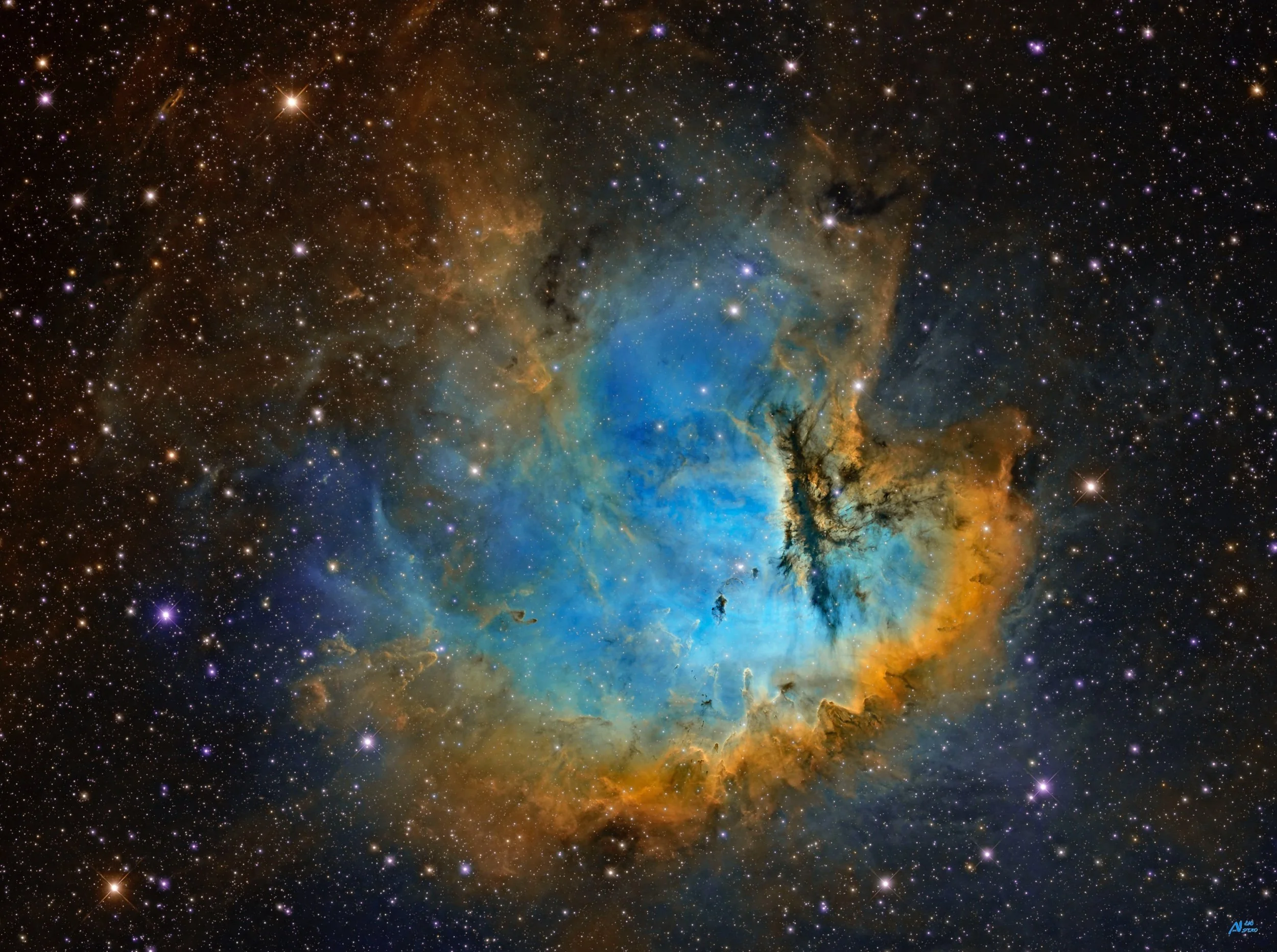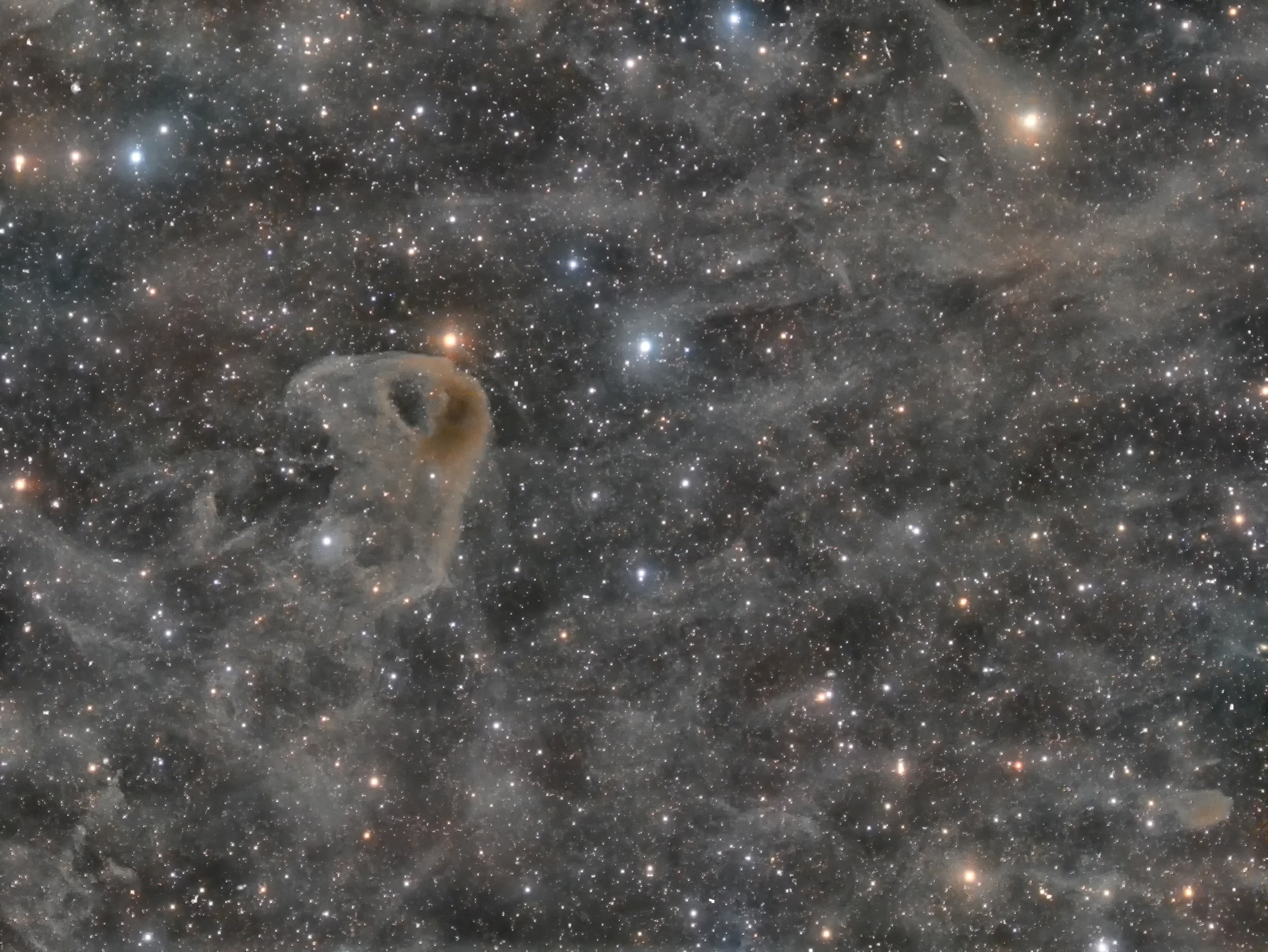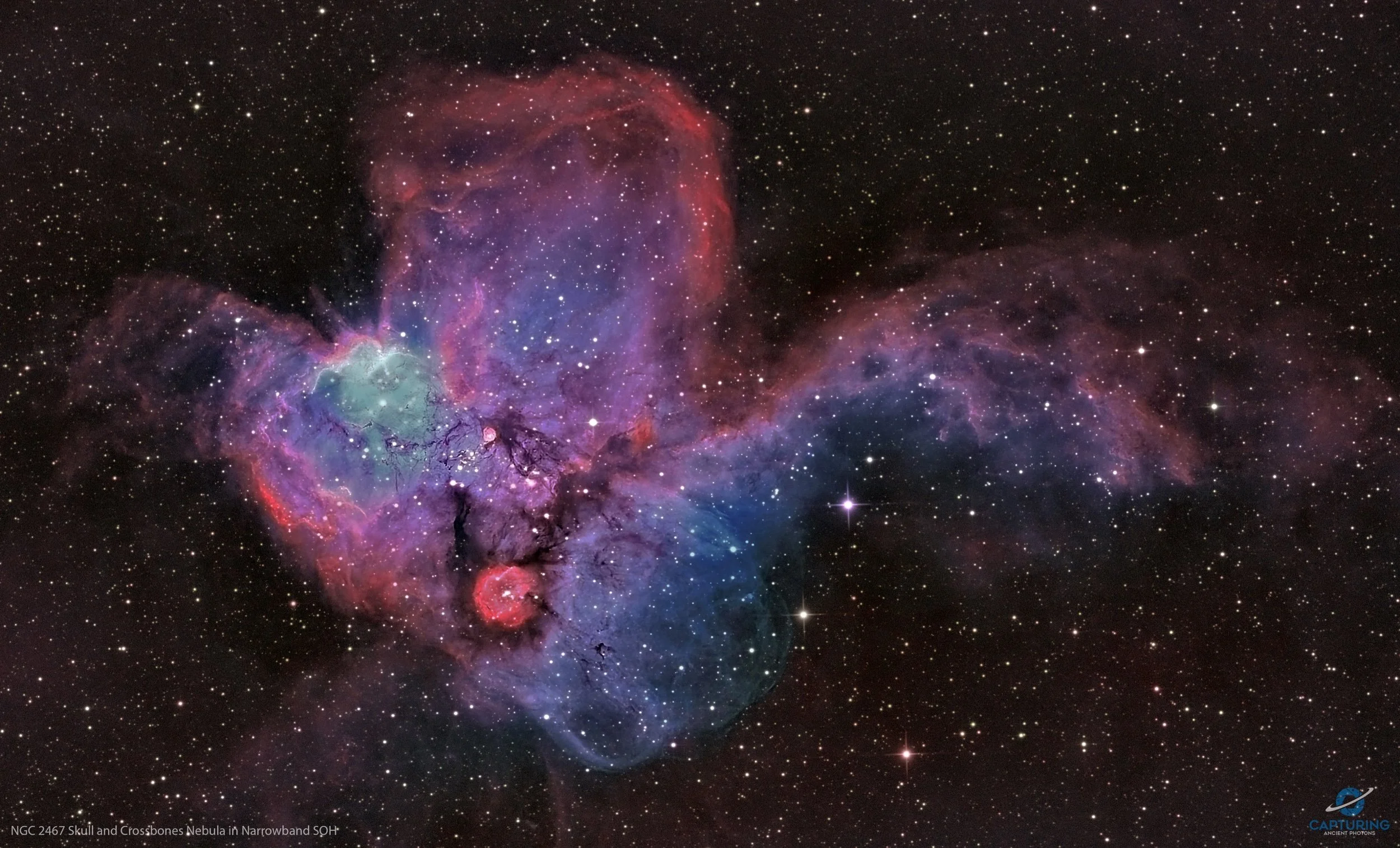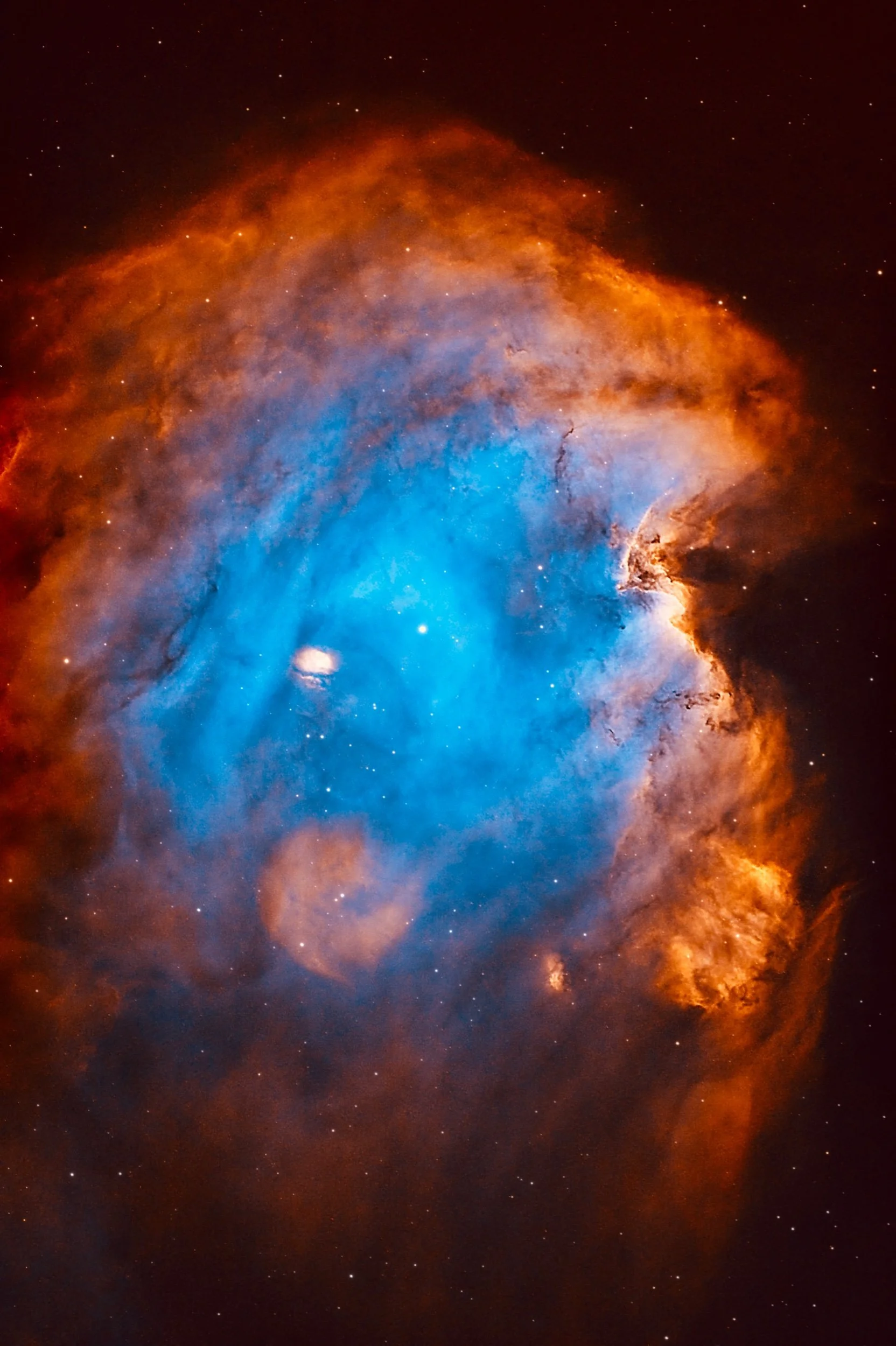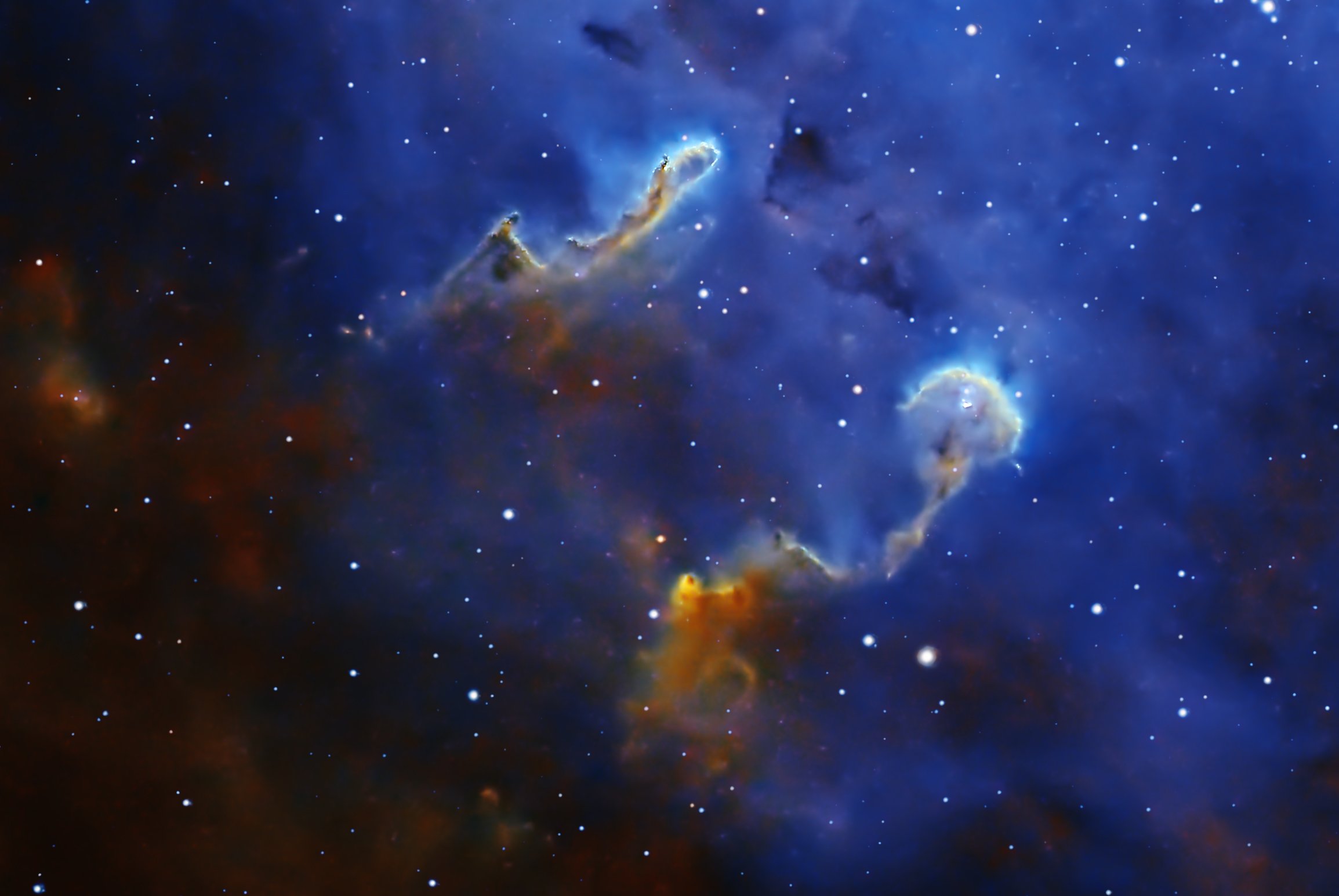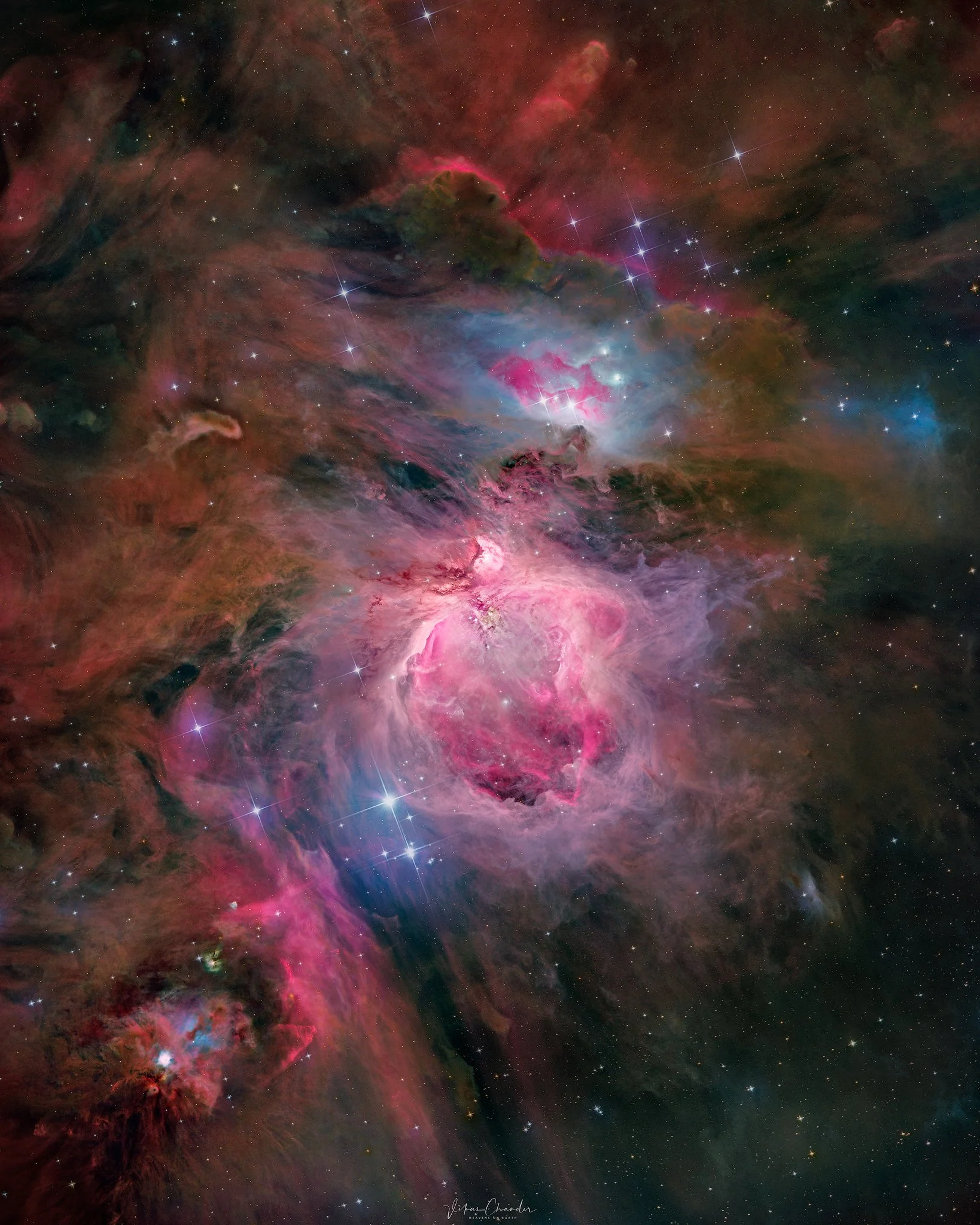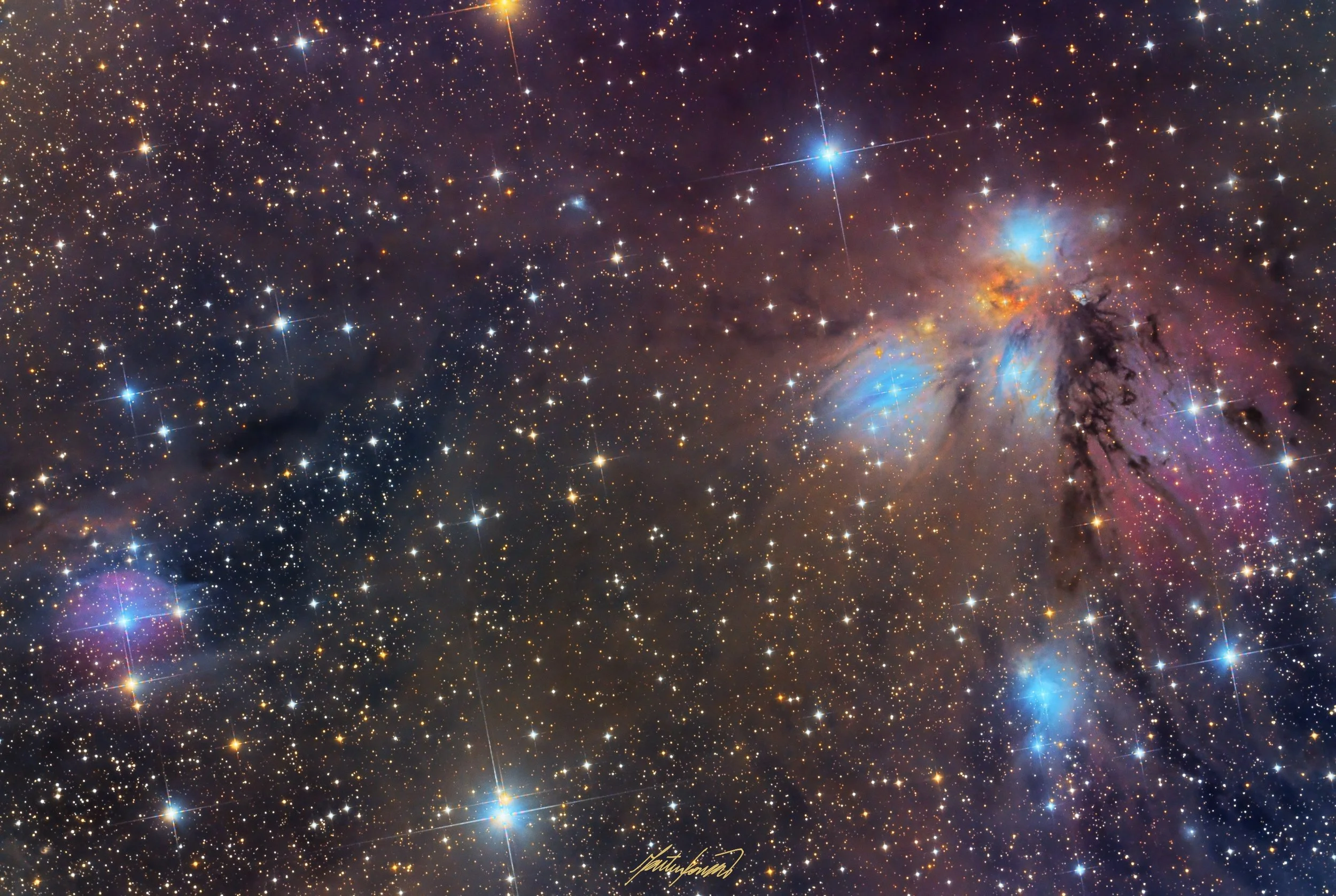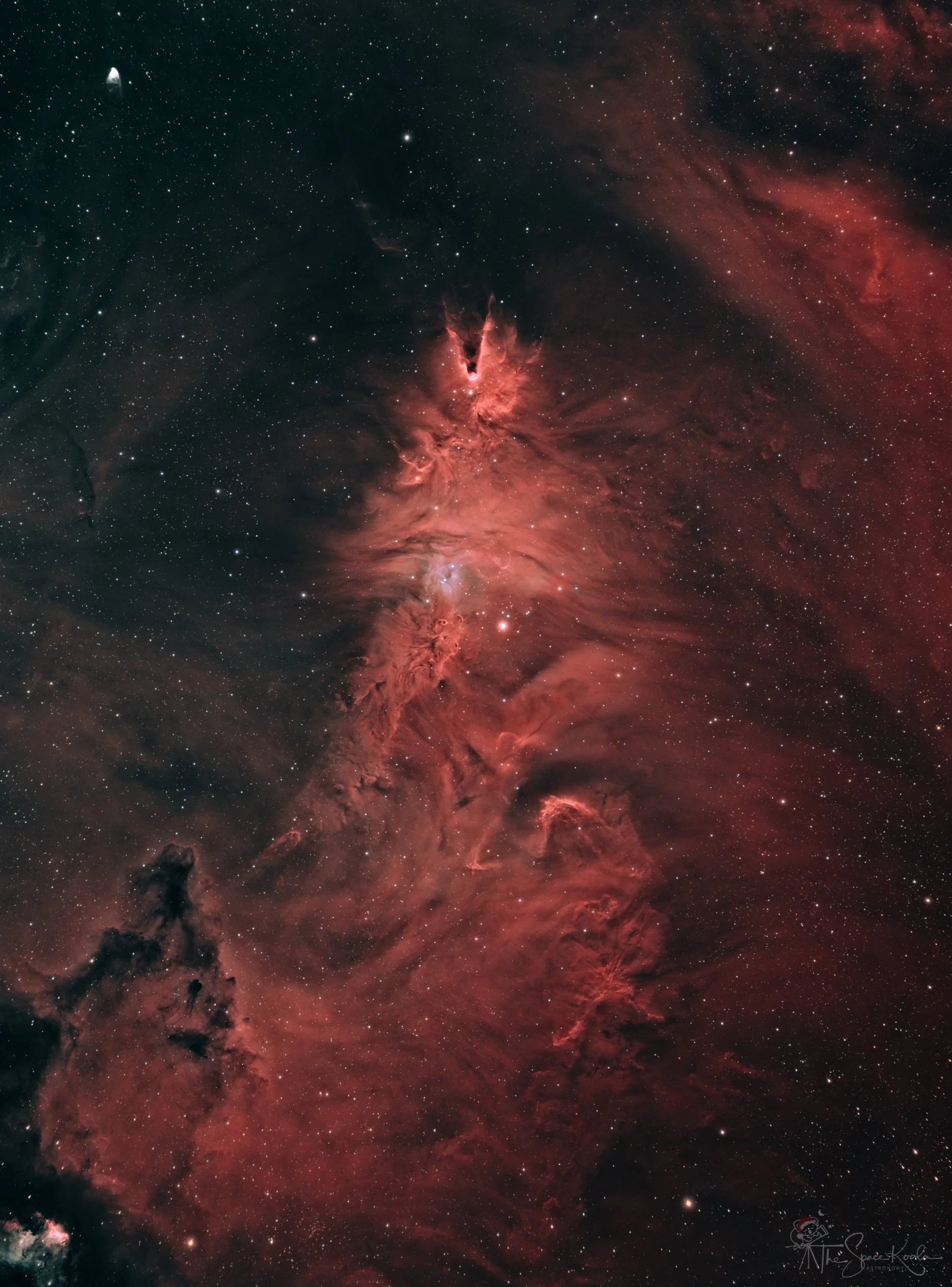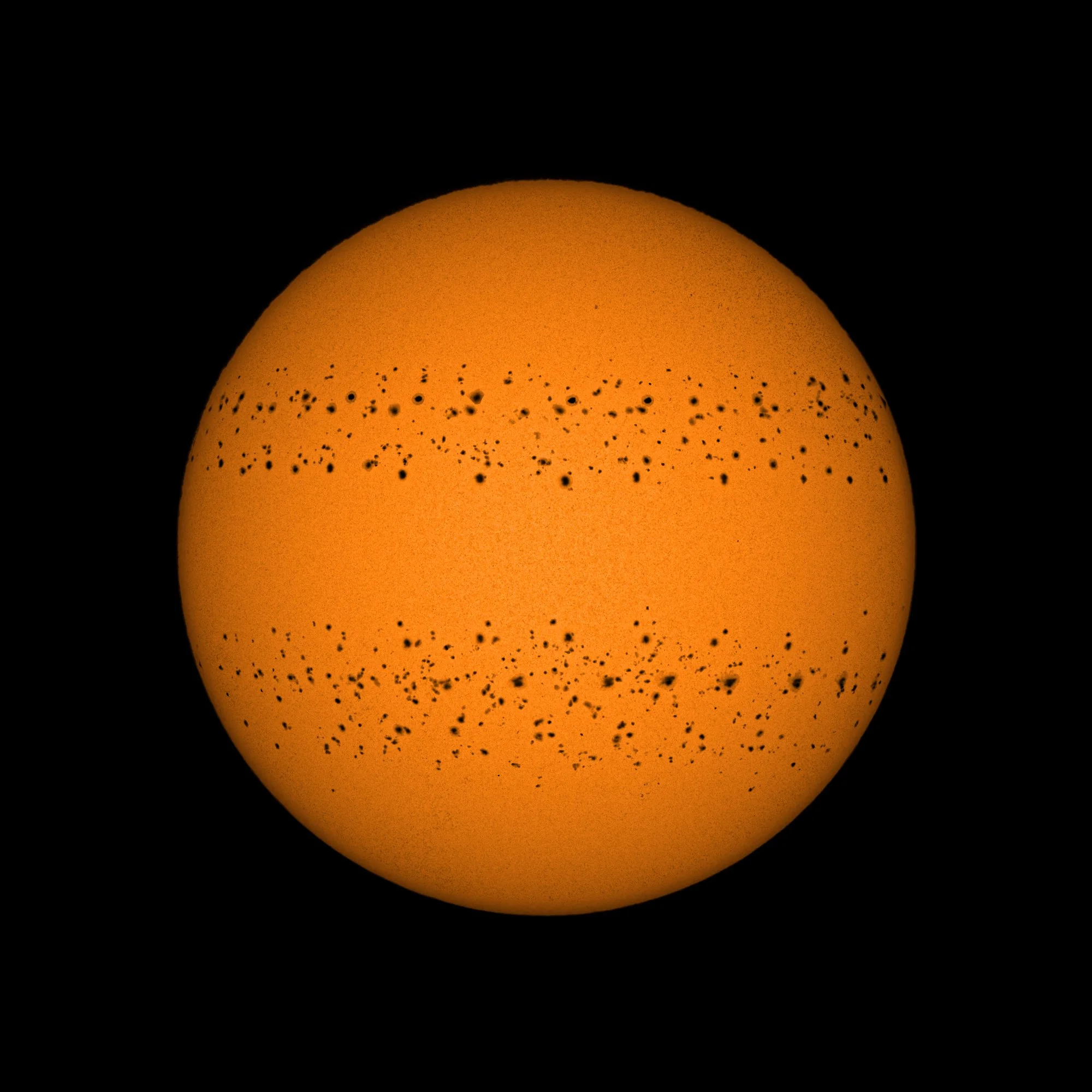
AAPOD2 Image Archives
Ngc281
Image Description and Details : NGC 281 is a HII region located about 10 000 light-years from Earth in the constellation Cassiopeia. With a diameter of about 100 light-years, it is part of the Perseus Arm. It includes or is close to the open cluster IC 1590, the double star HD 5005 and several Bok globules. It is visible through an amateur telescope in areas where the night sky is sufficiently dark. It is sometimes unofficially called the Pacman Nebula because of its coincidental resemblance to the eponymous hero of the arcade game Pac-Man.
This emission nebula was discovered by the American astronomer Edward Barnard in 1881.
Photo taken in Normandy France.
Equipment: Newton Skyvision 250/900 (F/D 3,6) on Skywatcher EQ8 mount, ZWO Asi 6200MM camera
36 H in S,H,O
Copyright: Francis Bozon
NGC 2030 - The Tarantula Nebula
Image Description and Details : A huge celestial furnace of star production, located outside our galaxy in the Large Magellanic Cloud.
Just over 75 hours of integration using narrowband filters were used to create this 2 panel mosaic.
William Optics RedCat51
ZWO ASI294MMPro
Skywatcher NEQ-6 Pro
Taken from Perth, Western Australia
Copyright: Daniel Faull
Moon O'Clock
Image Description and Details : The first Full Moon of 2023 is in the sky tonight opposite the Sun at 23:08 UTC. Big and beautiful, the Moon at its brightest phase should be easy to spot. Still, for quick reference images captured near the times of all the full moons of 2022 are arranged in this dedicated astro-imaging project from Sri Lanka, planet Earth. The day, month, and a traditional popular name for 2022's twelve full moons are given in the chart. The apparent size of each full moon depends on how close the full lunar phase is to perigee or apogee, the closest or farthest point in the Moon's elliptical orbit. Like the 2022 Wolf Moon at the 1 o'clock position, tonight's Full Moon occurs within a about two days of apogee. But unlike in 2022, the year 2023 will have 13 full moons that won't all fit nicely on the twelve hour clock.
Copyright: Niveth Kumar
The baby eagle
Image Description and Details : Fotografía realizada desde los cielos de Extremadura (spain)
Esprit-100
OrionAtlas-EqG
L-200x180.Rgb-90x180
Copyright: Ángel González Gordillo
NGC 2467 Skull and Crossbones Nebula
Image Description and Details : NGC 2467 or the Skull and Crossbones Nebula is an active stellar nursery lying in the southern constellation of Puppis located around 17,000 light-years away from Earth.
56 x 600s SOH subs shot @0C spread across 4 nights for a total integration time of about 9.5hrs
Equipment used:
Skywatcher 10" f4 Newtonian 250P
Skywatcher F4 Aplanatic Coma Corrector
Skywatcher NEQ6 Pro Hypertuned by Astronomy Academy Perth
ZWO ASI2600MM Pro Cooled Camera
Primaluce Sesto Senso2 Electronic Focuser
William Optics Uniguide 50/200mm guidescope
ZWO ASI290MM Mini Guide Camera
ZWO Electronic Filter Wheel
Antlia Pro 36mm unmounted filters
Rollon rolloff modified shed observatory
Bortle 5
Data acquisition software: NINA Astronomy Software
Processing software: PixInsight and Photoshop CC
Copyright: Capturing Ancient Photons
Owl cluster
Image Description and Details : Here’s some space gems 💎 the open star cluster NGC 457 also known as the owl cluster, it is an open star cluster 7,900 light away from the sun. It has an estimated age of 21 million years.
Taken Northwest Missouri September 30-2022 at the Backyard country observatory, using a Orion 8 inch f3.9 newtonian astrograph, with a coma correcter. Canon 60d unmodified, autoguider orion starshoot 60mm guide scope, all on a celestron AVX mount.
5 hours of 3 minutes subs RAW exposures, ISO-1250
Processing. Pixlinsight dynamic crop, dynamic background ext, non linear stretch in histrogram tran, NoiseXTerminator, BlurXTerminator, added luminous mask experimental transformation, star mask using the morphology trans for star reduction, added a luminous mask used curves, for saturation’s,
Photoshop: levels, selective color.
Copyright: Jared Bowens
Monkey Head Nebula
Image Description and Details : NGC 2174 / Sh2-252 - The Monkey Head Nebula, located about 6,400 light-years away in the constellation Orion.
Celestron 11” Edge HD with .7x reducer at f7. Celestron OAG with 174mm guide camera, CEM 70 mount, ZWO 2600 mm pro, ASIAIR pro+, ZWO 7 x 36mm EFW, ZWO EAF, 5 min subs shot with Chroma 3nm filters in SHO palette. 9 hours total. Processed in Pixinsight. Shot from my backyard, bortle 8.
Copyright: Richard McInnis
Ic447
Image Description and Details : IC447, Reflection Nebula in Monoceros. RGB + Duo narrowband OSC.
🗓 December, 28th to 30th. 2022
📍 Giruá, RS, Brazil. Bortle 4.
🔭 FotonAstro Astropipe 200MM F4 Newtonian Astrograph / AM5 Eq Mount
📷 asi2600mc camera
🕶 No Filter / Antlia ALP-T duo narrowband
- 113 x 180s (5,65h) No Filter (built in uv/ir asi2600mc)
- 32 x 300s (2,66h) with antlia duo narrowband filter
🧑💻 pixinsight, photoshop
Copyright: Martin Konrat
Sim 129 & 130 - The Tadpoles
Image Description and Details : This image was rather a surprise to me. I started shooting it last year and managed to scratch out a few more hours of data on it earlier this month. It's part of a much wider field, but when I zoomed in on the two objects that give the nebula its name, I was pleasantly surprised at the detail that came through.
The Tadpoles Nebula (I'll post the wide field in a day or two), designated IC 410, hosts a star cluster catalogued as NGC 1893. That cluster contains a number of very young, hot stars that formed in the larger nebula three million years ago and they have been busy sculpting the surrounding gasses with hot stellar winds ever since resulting in the two beauties in this shot designated Sim 129 (left) and Sim 130 (right).
The two tadpoles are each about 10 light years in length and are likely the source of ongoing star formation.
Details: Celestron EdgeHD 1100 telescope; 10Micron GM1000 HPS mount; ZWO ASI6200MM camera; Chroma 3nm narrowband filters; 18hrs exposure time.
Copyright: the Accidental Astronomers
IC 447, Reflection Nebula in Monoceros
IC 447 is a reflection nebula located in the constellation Monoceros. A reflection nebula is a cloud of dust and gas that reflects the light of nearby stars, giving it a glowing appearance. IC 447 is thought to be illuminated by the light of the young, hot star HD 45677, which is located near the center of the nebula.
An interesting feature of IC 447 is that it contains a number of protostars, which are stars that are still in the process of forming. The presence of these protostars suggests that IC 447 is an active site of star formation.
Orion
The Orion Nebula is a vast and colorful cloud of gas and dust located in the constellation Orion. It is one of the most famous and easily recognizable nebulae in the sky, and is often referred to as the "Great Nebula in Orion" or the "Orion Nebula Cluster".
Difficult to process but done well here, is the Orion Nebula Trapezium, a group of four young hot stars located within the center of the Nebula. The stars, which are known as Theta-1 Orionis A, B, C, and D, are some of the most massive and luminous stars in the Orion Nebula, and are thought to be less than a million years old.
Soul Nebula
The Soul Nebula, also known as the Embryo Nebula and designated as IC 1848, is a large emission nebula located in the constellation Cassiopeia. It is about 7,000 light-years away from Earth
Orion Rising
The Orion Complex is a group of stars and nebulae located in the constellation Orion. Seen here rising over a beautiful campsite. It’s an interesting region for astronomers because it contains a number of bright, young stars that are still in the process of forming. These stars are surrounded by clouds of gas and dust, which are the remnants of the material that originally formed the stars.
The Orion Complex is home to several famous nebulae, including the Great Orion Nebula (aka M42), a spectacular example of a region where new stars are being born. The Orion Complex is a popular target for amateur and professional astronomers because it is visible with the naked eye and contains a wealth of great targets.
NGC 1232 in LRGB
Observations of NGC 1232 have shown that it contains a significant amount of gas and dust, which is thought to be the raw material for star formation. The galaxy also has a number of young, bright blue stars, which are thought to be less than a few hundred million years old.
The Angel Nebula
NGC 2170 is a reflection nebula located in the constellation Monoceros. Reflection nebulae are clouds of dust and gas that reflect the light of nearby stars, giving them a blue or blue-white appearance. NGC 2170 is illuminated by a group of hot, young stars located just outside the nebula. These stars are thought to be less than a few million years old, making them some of the youngest known in the Milky Way galaxy.
Lights over Saana
The Northern Lights are more commonly seen in the polar regions because the Earth's magnetic field funnel the solar particles towards the polar regions. The intensity of the Northern Lights is affected by the amount of solar activity, so they can be more or less visible at different times.
Christmas Tree Cluster
Image Description and Details : I spent two nights imaging it with narrowband filters to highlight the abundant Hydrogen, Oxygen regions - with the plan to create a HOO image in order to keep the red color of Hydrogen - making this image even more Christmassy.
Telescope used: Tecnosky Owl Apo 130/900
Tracker mount: Rainbow Astro RST-300
Cemera: ZWO ASI 6200MM Pro
Taken in 12.2022 in Lugano, Switzerland
Ha: 9 hours, Oiii: 6 hours of integration time
Copyright: Luca Bartek @The_Space_Koala
A Year in the Sun
Image Description and Details : I imaged the Sun for 365 days between 25 December 2020 and 31 December 2021, missing just six days during this period. The project started with the aim of recording the journey of a single sunspot across the solar disc, but I managed to continue it for a year.
I blended the images to create a single shot, which records the rise of Solar Cycle 25. A total of 127 active regions appeared on the Earth-facing solar disc (AR 12794–AR 12921) during this phase and the image shows all of them. The sunspots create two bands on the solar disc, around 15–35 degrees north and south of the equator and gradually start drifting towards it – a phenomenon known as Spörer’s law.
Post-processing: PIPP, Photoshop
Equipment: Nikon D5600 camera, Sigma 150–600c lens, Thousand Oaks Filter (White-Light)
Exif: f/6.3, ISO 100, 365 individual exposures (1/80-second to 1/500-second), 600mm
Location: Kolkata, India
Copyright: Soumyadeep Mukherjee
Blue horsehead to rho
This one here was a difficult mosaic to do. I had a total of 12 sessions in APP due to different cameras, optics, exposure length, orientation, etc. I mixed some stuff from Telescope Live in with a ton of my own data from both here at home and from trips to Marfa TX. There were a total of 226x 120s, 180x 180s, 204x 300s, and 264x 600s totaling 77 hours and 32 minutes of integration taken with the Telescope Live AUS-2, CHI-5, CHI-6, Pentax K5 with Samyang 135 f/2, Pentax K5 with Borg 55FL f/3.6, Pentax K5 with WO Redcat 51, Pentax K3 with WO Redcat 51, and Pentax K3 with Borg 55FL f/3.6. All of this was processed in APP and Photoshop.
Copyright: Scotty Bishop
Planto and Vallis Alpes
Image Description and Details : With an image of such magnitude it is difficult for me not to comment on the two targets that stand out the most; Plato and Vallis Alpes.
Plato is one of the main targets of lunar astrophotography.
A good photo of Plato should show at least 3 or 4 smaller craters present on its floor, always in a darker hue than the surrounding terrain.
But every good self-respecting atrophotographer knows that it's not easy to make these small craters appear on your floor and, for that to happen, certain conditions must be met.
Firstly, an opening of no less than 250mm is ideal, not that it is impossible to register them with 200mm or even 180mm, but with 250mm it is much easier.
Secondly, the angle of incidence of sunlight must also be observed, if the terminator is too low and close, the contrast is too great making it difficult to record, if on the other hand the sun is too high, the smaller craters do not form shadows which it also makes it impossible to register them. I believe that the ideal is the Sun at an altitude of 30° to 45° so the contrast is not so great and shadows are still formed, facilitating their perception.
Thirdly, we must pay attention to seeing, with a bad seeing any recording is almost impossible, as these small craters disappear when the turbulence is strong.
I won't talk about focus because any mistake destroys a good result!
As a general rule, in order to get an impressive photo of at least some of these small craters, they would have to be visible briefly during the real-time screen capture on the lap top. If so, we learned that after the best stacked frames, these small craters will show up perfectly as seen in the attached photo.
Vallis Alpes, in the south of Mare Frigoris, not far from the Cassini crater and Plato's Great Eastern Plain, is one of the most spectacular valleys on the moon.
Seen in this image, Vallis Alpes (Alpine Valley) is a feature that extends 166 km from Mare Imbrium, running northeast to the edge of Mare Frigoris. This valley was discovered in 1727 by Francesco Bianchini. The valley is narrow at both ends and widens in the center to be about 10 kilometers in diameter.
The bottom of the valley has a flat, lava-flooded surface with a narrow 'channel' winding through the middle. This channel is generally thought of as a "graben", an area between two parallel faults that have fallen below the surrounding area. The narrow inner channel is believed to have been formed after the formation of the Imbrium basin, after the lava flows into the sea. It probably corresponds to a 'lava tube' that collapsed in a later geological episode due to the high velocity and low viscosity of the magma.
Very interesting to know that channels are common on the moon, considered one of the most fascinating volcanic features due to their wide range of scales (from 100 meters to over 100 km in length) and morphologies they present (linear, curved or sinuous). 🇧🇷
Channels typically form when lava flows erode the existing surface, melting the substrate, removing mechanical material, or a combination of thermal and mechanical processes. However, some may have been lava tubes, rilles, that suffered roof collapse after their formation.
Trying to detect this relatively narrow and winding channel that runs along the bottom of Vallis Alpes is one of the favorite challenges of lunar observers, its exact dimensions are not exactly determined, but its vision is a very satisfactory test, as are the small craters on the floor. Plateau.
I hope these tips are of some use to anyone like me who likes to venture into Lunar photography!
Copyright: Astroavani

